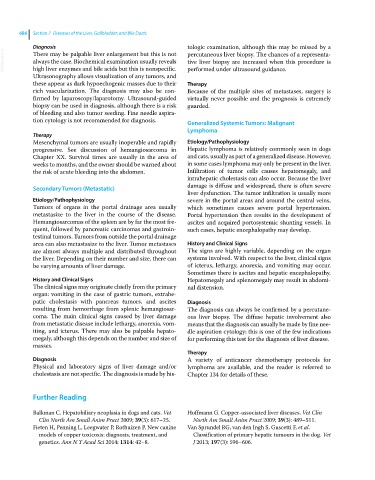Page 718 - Clinical Small Animal Internal Medicine
P. 718
686 Section 7 Diseases of the Liver, Gallbladder, and Bile Ducts
Diagnosis tologic examination, although this may be missed by a
VetBooks.ir always the case. Biochemical examination usually reveals percutaneous liver biopsy. The chances of a representa-
There may be palpable liver enlargement but this is not
tive liver biopsy are increased when this procedure is
high liver enzymes and bile acids but this is nonspecific.
Ultrasonography allows visualization of any tumors, and performed under ultrasound guidance.
these appear as dark hypoechogenic masses due to their Therapy
rich vascularization. The diagnosis may also be con- Because of the multiple sites of metastases, surgery is
firmed by laparoscopy/laparotomy. Ultrasound‐guided virtually never possible and the prognosis is extremely
biopsy can be used in diagnosis, although there is a risk guarded.
of bleeding and also tumor seeding. Fine needle aspira-
tion cytology is not recommended for diagnosis. Generalized Systemic Tumors: Malignant
Lymphoma
Therapy
Mesenchymal tumors are usually inoperable and rapidly Etiology/Pathophysiology
progressive. See discussion of hemangiosarcoma in Hepatic lymphoma is relatively commonly seen in dogs
Chapter XX. Survival times are usually in the area of and cats, usually as part of a generalized disease. However,
weeks to months, and the owner should be warned about in some cases lymphoma may only be present in the liver.
the risk of acute bleeding into the abdomen. Infiltration of tumor cells causes hepatomegaly, and
intrahepatic cholestasis can also occur. Because the liver
Secondary Tumors (Metastatic) damage is diffuse and widespread, there is often severe
liver dysfunction. The tumor infiltration is usually more
Etiology/Pathophysiology severe in the portal areas and around the central veins,
Tumors of organs in the portal drainage area usually which sometimes causes severe portal hypertension.
metastasize to the liver in the course of the disease. Portal hypertension then results in the development of
Hemangiosarcomas of the spleen are by far the most fre- ascites and acquired portosystemic shunting vessels. In
quent, followed by pancreatic carcinomas and gastroin- such cases, hepatic encephalopathy may develop.
testinal tumors. Tumors from outside the portal drainage
area can also metastasize to the liver. Tumor metastases History and Clinical Signs
are almost always multiple and distributed throughout The signs are highly variable, depending on the organ
the liver. Depending on their number and size, there can systems involved. With respect to the liver, clinical signs
be varying amounts of liver damage. of icterus, lethargy, anorexia, and vomiting may occur.
Sometimes there is ascites and hepatic encephalopathy.
History and Clinical Signs Hepatomegaly and splenomegaly may result in abdomi-
The clinical signs may originate chiefly from the primary nal distension.
organ: vomiting in the case of gastric tumors, extrahe-
patic cholestasis with pancreas tumors, and ascites Diagnosis
resulting from hemorrhage from splenic hemangiosar- The diagnosis can always be confirmed by a percutane-
coma. The main clinical signs caused by liver damage ous liver biopsy. The diffuse hepatic involvement also
from metastatic disease include lethargy, anorexia, vom- means that the diagnosis can usually be made by fine nee-
iting, and icterus. There may also be palpable hepato- dle aspiration cytology; this is one of the few indications
megaly, although this depends on the number and size of for performing this test for the diagnosis of liver disease.
masses.
Therapy
Diagnosis A variety of anticancer chemotherapy protocols for
Physical and laboratory signs of liver damage and/or lymphoma are available, and the reader is referred to
cholestasis are not specific. The diagnosis is made by his- Chapter 134 for details of these.
Further Reading
Balkman C. Hepatobiliary neoplasia in dogs and cats. Vet Hoffmann G. Copper‐associated liver diseases. Vet Clin
Clin North Am Small Anim Pract 2009; 39(3): 617–25. North Am Small Anim Pract 2009; 39(3): 489–511.
Fieten H, Penning L, Leegwater P, Rothuizen P. New canine Van Sprundel RG, van den Ingh S, Guscetti F, et al.
models of copper toxicosis: diagnosis, treatment, and Classification of primary hepatic tumours in the dog. Vet
genetics. Ann N Y Acad Sci 2014; 1314: 42–8. J 2013; 197(3): 596–606.

